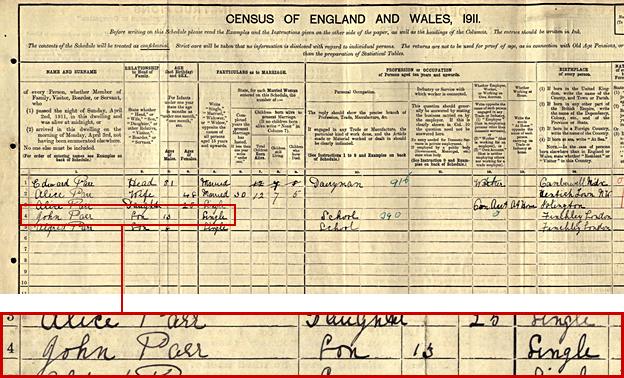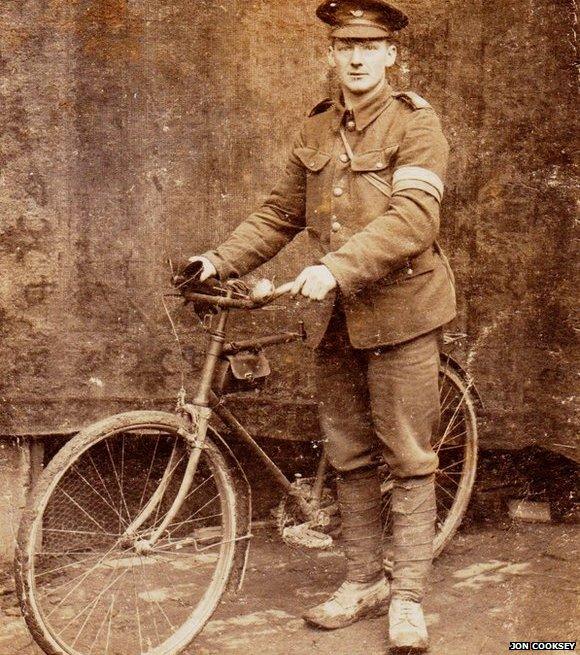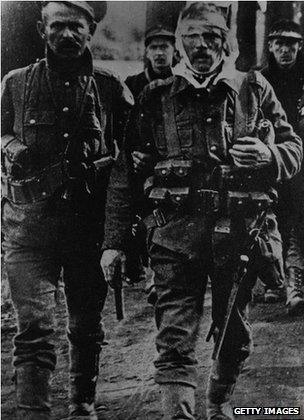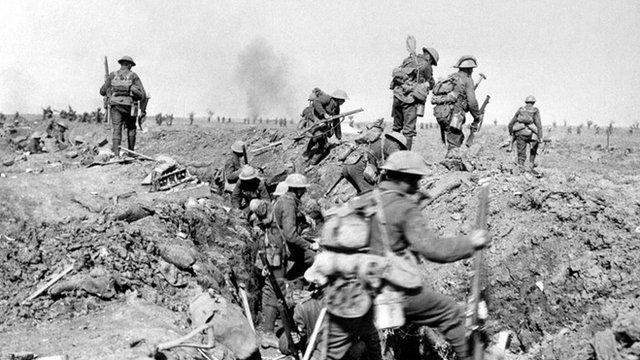WW1 mystery: Who killed Private John Parr?
- Published
Private John Parr was the first British soldier to lose his life in World War One but mystery surrounds his death, as Robert Hall reports
A ceremony is being held at the WW1 grave of Private John Parr - a teenager thought to have been the first British soldier killed in action in Europe - but 100 years on mystery still surrounds how he died and who killed him.
On 26 October 1914 Alice Parr arrived at the government's imposing War Office in London, seeking answers about her missing teenage son.
Seventeen-year-old Private John Parr had last been seen in August, on the eve of the Battle of Mons.
He had been sent to search for two missing platoons and his anxious mother feared the worst when she made her way to Whitehall.
"The youngest, the baby," says Iris Hunt, one of Alice's great nieces. "She must've been desperate."
As a quarter of a million other boys would go on to do, 14-year-old John had lied about his age to join the Army in 1912.

John Parr, the oldest son of Edward and Alice Parr, is shown as 13 years old in the 1911 census
The Parrs shared their small terraced house in Barnet, north London, with another family - overcrowded conditions the youngest brother left behind.
He was five years below the legal age at which he could be sent overseas to fight.
"He was probably looking for proper clothes and decent meals," according to policeman turned local historian Michael Crick, who has followed Private Parr's paper trail.
The brown-haired, brown-eyed boy was working as a caddie at his local golf course when he signed up.
"He was looking for adventure and something to do with his life," great-niece Iris says.
His life - like more than 700,000 others from the British Isles after him - was cut short on continental Europe.

But unlike those whose bodies were never found and who have no headstone, Private Parr entered history as the first of his comrades to die fighting Germany.
He would miss the horrors of the trenches, poison gas and mechanised warfare - shot and killed shortly after his 17th birthday.
"He's almost an iconic symbol of that first contact of the British Army with that massive German juggernaut crashing through Belgium on its way into France," says military historian Jon Cooksey.
There are no known photographs of the 5ft 3in teenager from the north London suburbs, described by his superiors as "clean, sober and intelligent" but "inclined to be insubordinate".
After joining his local regiment, the Middlesex, he became a reconnaissance cyclist, trained to ride ahead to retrieve information quickly for commanding officers.
When war broke out he and 1,100 other men in his battalion were shipped from Southampton to Boulogne-sur-Mer in northern France as the German army was advancing into Belgium.

Private Parr would have been on a bicycle like this one, held here by Albert Cooksey in 1916
The first major engagement of German and British troops in Europe came at the Battle of Mons on 23 August 1914 and there are conflicting reports of when exactly John went missing around this time.
As far as the military was concerned, he was still with his regiment almost half a year later.
"According to the records here, the man is still serving with his battalion," an official at the Infantry Records Office wrote on 27 January 1915.
Amid the administrative chaos at the start of the war, John's worried mother seems to have known more than those in charge.
"I've not heard from him at all and the War Office can tell me nothing," she wrote to the official, underlining the word "nothing".
"I have heard from Berlin," she went on. "The address is from a prisoner of war - one of my son's chums - to say that my son was shot down at Mons."
![Letter from Alice Parr to the "...someone would have wrote to me. I have heard from Berlin the address is from a prisoner of war, one of my sons chums, to say that my son was shot down at Mons that is the [illegible] went to war..."](https://ichef.bbci.co.uk/ace/standard/624/mcs/media/images/76655000/jpg/_76655744_letters_quotes1.jpg)
And this is where the mystery of Pte Parr's death begins.
It has long been thought that he came across German cavalry after heading off on his bike on a reconnaissance mission from where his unit was based near Bettignies - a French village on the border with Belgium - before the August battle.
Almost 70 years later, the curator of Pte Parr's local regimental museum recalled L/Cpl W Beart, one of the soldier's fellow cyclists, saying that, on 21 August 1914, the men had caught a "glimpse of Uhlans" - a German regiment.
L/Cpl W Beart made it back but the comrade he called "Old Parr" was never seen again.
Was one of the Uhlan soldiers responsible for the death of "Old Parr"?
'Friendly fire'
The shooting was apparently witnessed by an eight-year-old Belgian girl.
Andy Robertshaw, a historian who traced the girl as an elderly woman, says she remembered Private Parr waving his comrade away when the two men were shot at.
"Parr was in a ditch, shooting down her road to the east to give his mate time to get back to base," he says.
The first British soldier died, the woman said, after a German soldier ran through her garden to shoot him.
But on that night, according to Jon Cooksey, there is no way the men could have encountered any enemy soldiers.

Walking British and Belgian wounded at Mons
"Looking at all the documents," he says, "it's more likely he was killed on the 23rd at the Battle of Mons."
He adds that John Parr's burial by the Germans in St Symphorien Cemetery, "just three miles from where his battalion fought that day", backs this up.
Given the battle claimed some 1,600 British casualties, this raises the prospect that Private Parr may not have been the first to fall.
Jon Cooksey has studied troop movements and war diaries on both sides.
He says if Pte Parr was killed on the date on his headstone, it must either have been by a trigger-happy Belgian "terrified of the German hordes", so-called friendly fire from a French cavalry patrol or, worse, from his own side.
"The point where he is supposed to have been killed couldn't by any stretch of the imagination have been correct," the author and broadcaster says.
On 21 August, according to the battalion war diary, John Parr's regiment was 11 miles south of the position it would take up to fight at Mons - German units did not cross the Mons-Conde Canal until the afternoon of 23 August.
Position of 4th Battalion on 21 August 1914

There is no mention in any of the brigade or divisional diaries of any contact with the enemy, Jon Cooksey says.
Nor is there any record of contact with the British in the Germans diaries.
"And what a coup that would have been for that German soldier," he adds. "No such record exists."
Andy Robertshaw acknowledges it could actually have been a Belgian who unwittingly fired the shot that killed Pte Parr.
"If you're a Belgian, you've never seen a British soldier before," he explains.
The first contact the Germans and British report is on 22 August 1914, just after dawn, when cavalry patrols from the two sides meet.
And this, according to Jon Cooksey, is still another two miles north of where Pte Parr is supposed to have been killed.
Back in London, it is now January 1915 and a fraught Alice Parr has heard nothing from those running the war.
She received a letter from the captain of John's regiment.
'No closure'
"He informed [me] that my son Private John Parr has been missing from the regiment since August the 23rd 1914 and has not been heard of since," she wrote again to the records office.
"I should be very grateful for any information as to his whereabouts."

There is nothing to indicate when Alice or her family were finally told John Parr would not be coming home.
"They didn't get any closure at all," says ex-policeman turned local historian Michael Crick.
"And even when they did learn months later that he was killed, they were never able to find out the circumstances."
Official records refer to the "late" Private Parr almost a year after his death, on 19 August 1915 but shed no light on what actually happened to him.
"In truth, the mystery is probably never going to be solved," Jon Cooksey says.
- Published14 January 2014
